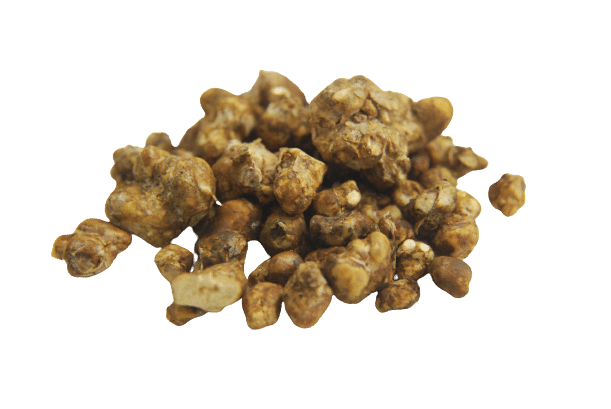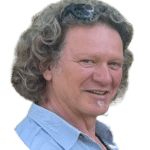Truffle therapy using the magic truffle
Magic truffles
Most people are familiar with microdosing or using psilocybin in the form of mushrooms or magic truffles. What exactly are the truffles and why are therapeutic sessions done with them? What is so magical about the magic truffles?
Truffleceremony
Do you already know what truffles are and are you looking for a group ceremony with magical truffles? Then view our page about truffle ceremony via the button below.

Sclerotia from magic mushrooms
Bee truffle therapy magic truffles are used. Truffles and magic mushrooms (magic mushrooms) are both psychoactive fungi from the same organism that contains psilocybin. The main difference between the two lies in their appearance: mushrooms have a stem and a cap, while truffles have a knobby shape and no stem. The concentration of psychoactive substances may also be different, but if the amount of psilocybin present is corrected, the amount of psychedelic effects may correspond.
What is less known is that truffles are actually the sclerotia of mushrooms. The sclerotia is a compact, spherical mass of mycelium and nutrients that forms underground in response to drought and food shortages.
In a sense, truffles can be considered a mushroom survival mechanism. They contain the same psychoactive substances as mushrooms and are therefore used for their hallucinogenic effects. Although truffles are less known than mushrooms abroad, in the Netherlands we mainly only use truffles due to legislation. Truffles and magic mushrooms have similar effects on the mind and perception of users.
The truffles contain several psychoactive substances, including psilocybin and psilocin, which are considered the main active components for truffle therapy. Baeocystin and norbaeocystin are additional substances found in lower proportions.
Psilocybin is a tryptamine that turns into psilocin in the human body. This provides the main psychedelic effects of these mushrooms. Baeocystine and norbaeocystine are considered less potent psychoactive agents present in several types of mushrooms.
The psychoactive effect of truffles used during truffle therapy mainly comes from the substance psilocybin, which is present in high levels. Psilocybin as an individual substance is now widely investigated in scientific studies to remedy mental disorders. This does not examine whether the other psychoactive substances in magic mushrooms and truffles have an additional positive influence on the therapy.
Magic truffles or psilocybin?
Using psilocybin from synthetic or purified sources can provide greater accuracy and control in scientific research. Magic truffles and mushrooms contain varying amounts of psilocybin, making it difficult to monitor doses and ensure consistency across study participants. In clinical trials, researchers use precise doses of psilocybin to study its effects on brain activity, emotions and behavior in different populations. By using a standardized, controlled substance, researchers can more accurately assess the effects of psilocybin and gain a better understanding of its therapeutic potential. Psilocybin is therefore preferred over truffles in scientific research because it offers greater precision, consistency and safety.
For therapeutic sessions with magic truffles, no exact amount is required and a deviation of approximately 10% can be used. It doesn't matter if someone takes a few mg more or less psilocybin than expected. An additional advantage is that the other psychoactive substances, which also influence the effect to a lesser extent, can provide a broader experience than psilocybin alone.
In short, a precisely measured amount of psilocybin is useful for research, but not necessary for truffle therapy.
Psilocybin from magic truffles in science
Scientific research currently shows that psilocybin may be a promising approach in the treatment of various conditions, such as depression, anxiety, addiction, cluster headaches and even Alzheimer's disease. Incredibly, psilocybin therapy is not only extremely effective, but also safe and well-tolerated compared to traditional medications.
Depression treatment
Psilocybin has an anti-inflammatory effect on the brain and, together with altered perception, can cure depression, according to various scientific studies.
Post-traumatic stress disorder (PTSD)
Scientific research indicates that psilocybin may be effective in treating PTSD, in addition to anxiety disorders. The first results are promising.
Social anxiety disorder (SAD)
A scientific study at the University of Zurich has shown that a single dose of psilocybin reduces symptoms of SAD in participants with social anxiety disorder. The long-term effects of this treatment are still unknown according to the researchers.
Generalized anxiety disorder (GAD)
A scientific study conducted at the University of Arizona examined the effects of psilocybin in the treatment of generalized anxiety disorder. The study shows that psilocybin-assisted therapy can significantly help reduce anxiety levels.
Addictions
Psilocybin is being scientifically investigated as a potential treatment method for addictive disorders, primarily tobacco and alcohol addiction. Numerous studies have already shown promising long-term results in reducing cravings and promoting abstinence.
Obsessive-compulsive disorder (OCD)
There is scientific research available showing that psilocybin may be a possible treatment for OCD symptoms. The research shows that microdosing can help manage symptoms better and make daily activities easier.
Cluster headache
Psilocybin has been scientifically investigated as a possible treatment for cluster headaches, a very severe and debilitating form of headache. Some patients have reported positive results after treatment with psilocybin.
Migraine
Although limited research, some scientific studies show that psilocybin may provide relief in the treatment of migraines. The positive effects appear to be the result of a change in blood flow in the brain.
Anorexia nervosa
Research is currently underway into the potential role of psilocybin in the treatment of anorexia nervosa, but further studies are needed to confirm its efficacy and safety. However, previous studies have already shown that it can improve the relationship with nutrition.
Psychosomatic complaints
There are currently no specific scientific studies that focus on psilocybin and psychosomatic complaints. However, some broader research and evidence suggests that psilocybin may have a positive impact.
How does psilocybin/psilocin work?
The results of the scientific studies are very good and the success rate of the treatments compared to regular care is many times higher. Some of the positive effects can be attributed to the physical effects in the brain such as changes in neurochemistry, blood supply, neuroplasticity, new brain connections and brain waves. In addition to these measurable effects, the subjective experience of the person undergoing the psilocybin session can also play an important role.
Physical effects
Neurochemistry
The use of psilocybin causes an increase in stimulation of the serotonergic receptors after it has been converted to psilocin. The interaction between psilocybin and serotonin receptors leads to an increase in serotonin release and changes in serotonin transmission in various brain areas. This impacts neurochemistry on multiple levels, including promoting neuroplasticity through the additional stimulation on serotonergic receptors, which increases the production of BDNF. BDNF can stimulate the growth of neural branches (dendrites) and the number of dendritic spines, which may contribute to long-term changes in brain structure and function. Psilocin specifically binds to and activates 5-HT2A receptors, which control the regulation of mood, perception and cognition. By stimulating these receptors, psilocybin alters signal transmission in the brain, resulting in the experience of hallucinations, altered consciousness, and other effects. It also promotes the release of serotonin into the synaptic cleft, leading to increased serotonin concentrations in certain parts of the brain, which can lead to altered neuronal activity and communication.
Amygdala
The amygdala is an important brain region for processing emotions, including fear and stress. Scientific research has shown that psilocybin can effectively reduce activity in the amygdala, which can contribute to reducing feelings of stress.
Different blood supply
Functional magnetic resonance imaging (fMRI) shows that psilocybin can alter blood flow to several brain areas. This leads to reduced activity in the prefrontal cortex and the default mode network (DMN), a network of brain areas involved in self-awareness, time and memories. Arterial spin labeling (ASL) MRI shows that psilocybin increases global cerebral blood flow, indicating an increase in metabolism and neuronal activity in certain areas of the brain. These findings are scientifically important.
Brain waves
Psilocybin affects brain waves in the brain, which can be measured with electroencephalography (EEG). A study from Johns Hopkins University found that psilocybin shifts brain waves from alpha-like to theta waves. Alpha activity (8-13 Hz) is associated with a relaxed but alert state, while theta activity (4-7 Hz) is associated with dream-like and deeper meditative states.
Lowered inflammation levels
Psychedelics such as psilocybin have powerful anti-inflammatory properties. They lower the production of pro-inflammatory cytokines and restore balance to the immune system. This leads to less "noise" in the brain, more mental clarity and better emotional balance. At Triptherapie, we purposefully deploy psilocybin to reduce low-grade inflammation, contributing to recovery from symptoms such as depression, fatigue and chronic pain.
Subjective experience
Better mood
Through increased stimulation of serotonergic receptors, psilocybin can induce various moods and experiences. Subjective experiences such as connection, empathy, love, and emotions such as sadness, joy, happiness, and wonder are common during a psilocybin trip. Thanks to psilocybin's action on serotonin, it can alleviate depressive symptoms caused by serotonin deficiency.
Less self-awareness
With less self-awareness, events appear more connected because there is less need to distinguish between the self and the environment. When the self is looked at with less self-awareness, it sometimes seems as if it is about someone other than the actual self. From this perspective, it is easier to speak honestly about the self without emotional barriers. This can contribute to openness, which can have a great advantage in processing the past, talk therapy, self-examination and personal growth.
Stress reduction
An increased sense of connection and more acceptance can make fears and stress more acceptable, as they have less control. With stronger psilocybin sessions, the sense of self can disappear completely, after which fear no longer plays a role, as self-protection is no longer needed. This has been scientifically established.
New insights
Psilocybin changes the functioning of the brain in a different way than normal. This can lead to new insights and discoveries of cross-connections. The course of this cannot be predicted in advance. An additional advantage of such sessions is that curiosity is rewarded and people often remain curious about themselves, others and the world after the session. Scientifically speaking, these are interesting results.
Spiritual insights
During a psilocybin trip, some people report scientific or mystical experiences. This can be accompanied by feelings of transcendence, a sense of meaning and connection to something bigger than themselves. Just as science can provide confidence, a spiritual experience can also provide greater peace and health.
Healthier choices
Many people who have experienced a deeper trip on psilocybin have shown that there is a connection between a healthy body and a healthy environment. By promoting better health of one's body, mind, people and environment, an increase in feelings of love for oneself and the universe has been detected. The results suggest that this may contribute to changes in perception, health and quality of life.
The amount of truffles for therapy
The effects of psilocybin vary and depend on individual sensitivity, character, mood, additives and dose. At higher doses, stimulation of the serotonin receptor, also known as the 5HT2a receptor, increases. This increased stimulation leads to the effects of psilocybin. The effects of psilocybin are divided into different levels.
| Psilocybin Dosage | Trip level | Duration (h) | Eligibility |
| Microdose | 1 | 2-3 | Beginner |
| Medium dose | 2-4 | 5-6 | Beginner |
| High dose | 4-5 | 6-7 | Some experience |
| Heroic dose | 5 | 7-8 | More experienced |
During trip level 1, the negative feelings of serotonin depression disappear. Because the communication of the hemispheres of the brain changes, music will sound deeper, colors will become brighter and the environment will become more tangible. During this phase people are more open and socially involved and open/honest. Triple level 1 occurs in microdosages as the maximum trip level. With psilocybin therapy with medium, high and heroic doses, you will initially briefly enter trip level 1 and return to trip level 1 at the end of the session.
Brighter perception of colors, visual effects such as the movement and “breathing” of objects, walls, etc. With closed eyes, 2-dimensional patterns can be observed. Due to changes in short-term memory, the user experiences continuous distracting thought patterns, alternating with extreme focus. The natural filter in the brain is bypassed, which increases creativity, among other things. During this phase, cross-connections can already be discovered. Cross-connections about, for example, why certain things happen and how you can deal with them.
Very clearly noticeable visual effects. Everything seems bent or distorted. Patterns can be seen on walls, objects, faces, etc. Mild hallucinations, such as the effect of flowing rivers in wood grains or other structures. Some confusion of the senses, for example seeing sound as color, etc. Time distorts, making everything seem to take place in the “now”. From this level it is already possible to connect with the subconscious brain, while it can still be controlled very well. There may be fears in the subconscious that cause stress without people consciously realizing it. This level is useful to combat those fears from the subconscious. Fears often come from the past and/or the future. These fears are not realistic at the moment and acceptance is possible during this trip level
Strong hallucinations, such as objects morphing into other objects. Perception of the ego fades, for example objects can start talking to you or you feel contradictory things at the same time. Some loss of reality, time becomes an incomprehensible concept. Possible experience of out-of-body experience. Mixing stimuli from different senses. Because of the loss of ego and therefore the loss of self-protection, one is harsh but honest about oneself during this phase. Problems can be addressed and given a place. The connection with the subconscious is very high at this trip level, which means that a lot can be learned about who someone is, while it seems as if it is someone else because of the loss of ego.
Total loss of visual connection with reality, senses no longer work in the “normal” way. A total loss of ego. Users feel themselves merging with space, other objects or the universe. The loss of reality becomes so bad that it is difficult to explain or put into words. This level differs from the other levels in that the actual universe in which things are located ceases to exist. During this phase there is absolutely no control possible from the ego. The connection with the subconscious is now maximum. During trip level 5, just like at trip level 4, it is difficult to formulate words and there is therefore little point in talking. It is, as it were, a dream that cannot be influenced by yourself. This phase can give you insights in an initially incomprehensible way. Level 5 psychonauts often call the trip experiences mystical, the most beautiful experience of their lives or frightening. Control freaks in particular find it scary at first. It is not wise to do this without experience with psychedelics.
Truffle therapy at Triptherapie
At Triptherapie we are proud of our careful preparation of psilocybin sessions. Our team carefully assesses your unique needs and goals during a thorough intake process so we can tailor our recommendations. Furthermore, we believe that our comprehensive approach to preparation sets us apart. As part of our standard service offering, we offer a range of benefits that make your truffle therapy as productive and transformative as possible. Let us help you unleash psilocybin's full potential and create lasting change in your life.
Before the session
- Screening for safety based on the intake
- Nutritional advice in preparation for psilocybin use
- Supplement advice to improve neurochemistry
- Video and reading suggestions that can come to life during the session
- Small assignments that can help prepare for the session
During the session
- Introductory conversation whose topics discussed can come to life during the peak
- Various playlists with treatment-specific music
- Aromatherapy
- Space for introspection
- Experienced guidance
- Home visits are possible
- Use of our locations is possible
After the session
- Space to discuss immediately after the session
- Tips for recovery after the psilocybin session will be sent by email
- An integration conversation a few days after the session
- Motivational messages to maintain success even after the psychedelic session
Choosing a supervisor
Which counsellor suits you best is very personal. We have both male and female counsellors with different backgrounds. Our counsellors/therapists can make home visits as long as it is within the Dutch borders and within their working area. You can use your own home, holiday home, private Airbnb or hotel for this on-site service.
With a background in chemistry, a passion for philosophy, combined with extensive knowledge of psychology and health, his approach is holistic. Marcel is a full-time trip facilitator. With over 2200 guided sessions, Marcel has the most experience of our team.
Ronald is a psychosocial therapist and has completed the following training courses: Jungian Philosophical Therapist, Psychodrama Therapist, Master Voice Dialogue, Transformation Psychology, Internal Family System (IFS), Mindfulness and Compassion Trainer.
Janneke studies Applied Psychology, is a lifestyle coach, provides initial customer contact, draws up lifestyle plans and performs administrative tasks. She also acts as a confidential counselor. In addition to these tasks, she is available to a limited extent for coaching sessions.
Sascha has a good foundation as a psychedelic therapist with her studies in psychology, a Master's degree in Clinical Psychology and work experience in addiction care, (specialist) mental health care and rehabilitation as a psychologist. She has additional training in cognitive behavioral therapy and EMDR.
As a psychologist, Reineke combines both regular and alternative care methods to provide the best possible treatment. She uses various techniques, such as talk therapy, yoga, breathing exercises and EMDR in combination with the therapeutic effects of psychedelics.
Gijs has 20 years of experience in outpatient mental health care. He taught and supervised the MGZ-GGZ course at HAN (Arnhem Nijmegen University of Applied Sciences). Gijs has also developed extensively in mindfulness, talk therapy, neurofeedback, meditation, compassion training and ACT.
Contact or intake
Would you like to sign up for a psychedelic session at Triptherapie? Thanks to our method and guidance, you drastically reduce your chances of having a "bad trip" while increasing your therapeutic potency! Fill in the intake now with no obligation so we can see together what is possible for you. Do you have any questions? Then take a look through our FAQ section or contact us.
Frequently asked questions about truffle treatments
The first step is to determine whether you are participating in a truffle ceremony in group or prefer to opt for a individual session.
Group retreats usually take place in Schiedam, near Rotterdam. These two-day ceremonies are fully legal and professionally supervised. Check here the available dates for truffle ceremonies.
Private sessions can also be customised, either in Schiedam or at a location you rent (such as an Airbnb or hotel in Amsterdam). Use this price and location tool To see what is feasible.
What to arrange:
- Pre-filling the intake - this is mandatory and determines whether you are medically and psychologically fit.
- Arrive at least one day before the session - especially if you are going on a long trip, so you are rested.
- Book a hotel near Schiedam or Amsterdam - Useful for the day before and after the ceremony.
- Planning extra rest day after ceremony - to integrate your experience and give your brain time to recover.
Sample itinerary:
- Day 1: Arrival in the Netherlands, overnight stay nearby
- Day 2: Truffle ceremony (afternoon to evening)
- Day 3: Integration morning (in case of group retreat) and rest day
- Day 4: Return trip
Which ceremony suits you?
- Do you want to share the experience with others and are flexible in scheduling? Then choose a truffle ceremony in group.
- Do you need privacy, individual counselling or a specific help request (such as trauma, burnout, anxiety)? Then choose a private truffle session.
A duo truffle session is quite possible at Triptherapie and can actually be a beautiful form to take a deep inner journey together. For example, as partners, friends or family members.
During a truffle session or truffle ceremony at Triptherapie, the dosage is carefully tailored to your personal situation, intention and experience. So there is no fixed amount for everyone, but there is a guideline that usually lies between 15 and 45 grams of fresh truffles. This corresponds to a trip level between 3 and 5 and is suitable for therapeutic and transformational work. In some cases, one can also choose to dose even higher, such as 60-90 grams of truffles.
Yes, truffle therapy can certainly be used as relationship therapy. This is also actively offered as such at Triptherapie. For many couples, it is a transformative experience beyond what traditional couples therapy can often offer.
During a truffle session together, defence mechanisms come to rest, empathy is strengthened and space is created to truly understand each other's inner world. The psilocybin in truffles helps to let go of stuck patterns, feel through unprocessed emotions and reconnect with your partner on a deeper, often wordless level.
A session is always tailored to your relationship issues and emotional safety. Think of themes such as attachment, trust, intimacy, communication or shared trauma. The therapist carefully guides you through this, leaving room for both joint and individual processes during the journey.
Bee microdosing is often dosed too low, so you may only experience the useful placebo effect. That is, you do feel better or clearer, but the effect is not necessarily due to the psilocybin itself, but to your expectation, intention and behavioural change. While this can certainly be valuable, the effect when microdosing often remains subtle and superficial, especially when deeper emotional or psychological issues are involved.
Bee macrodosing (high dosage during a guided session) you consciously embark on a deep inner journey where you access unprocessed emotions, unconscious patterns and sometimes even traumatic memories. Instead of alleviating symptoms, macrodosing focuses on deep processing and transformation. With us, this takes place in a controlled setting with a trip sitter or therapist, like a truffle session or psilocybin session.
Our practical experience shows that many people who started microdosing only experienced real breakthroughs after a full-fledged truffle therapy session. Microdosing can be useful as preparation or integration after such a session to better retain the insights in daily life.
Truffle therapy is not medical treatment in the regular sense and is therefore not covered by health insurance. It falls under the heading of alternative or complementary care, which is outside the Netherlands' regular healthcare system.
General FAQ
Should you be looking for another question and answer? You can then also choose to use the search function on our site, consult the frequently asked questions section or ask our chatbot Trippy.
Recent Q&A questions
Psychedelic session for clients from abroad
How do I book psychedelic therapy in the Netherlands when coming from abroad? What are the possibilities?
NPS law and MDMA analogues
Which analogues of MDMA will become illegal from 1 July 2025 with the entry into force of the amended opium law?
Psychedelic therapists
Which of the therapists at Triptherapie are trained psychologists and the like?
Truffle ceremony with psilocybin
Approximately how many truffles or mg of psilocybin do you get at magic truffle ceremonies?





